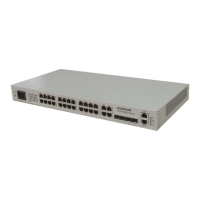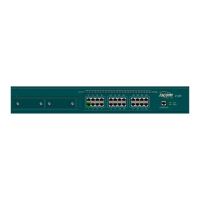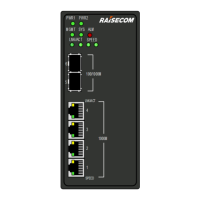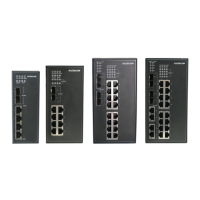Raisecom
ISCOM2600G-HI (A) Series Configuration Guide
Raisecom Proprietary and Confidential
Copyright © Raisecom Technology Co., Ltd.
PVLAN adopts Layer 2 isolation technology. Only the upper VLAN is
visible globally. The lower VLANs are isolated from each other. If you
partition each interface of the switch or IP DSLAM device into a lower
VLAN, all interfaces are isolated from each other.
QinQ is (also called Stacked VLAN or Double VLAN) extended from
802.1Q, defined by IEEE 802.1ad recommendation. Basic QinQ is a
simple Layer 2 VPN tunnel technology, encapsulating outer VLAN Tag
for client private packets at carrier access end, the packets take double
VLAN Tag passing through trunk network (public network). In public
network, packets only transmit according to outer VLAN Tag, the
private VLAN Tag are transmitted as data in packets.
A network security mechanism, used to solve problems of network delay
and congestion. When the network is overloaded or congested, QoS can
ensure that packets of important services are not delayed or discarded
and the network runs high efficiently. Depending on the specific system
and service, it may relate to jitter, delay, packet loss ratio, bit error ratio,
and signal-to-noise ratio.
Rapid
Spanning Tree
Protocol
(RSTP)
Evolution of the Spanning Tree Protocol (STP), which provides
improvements in the speed of convergence for bridged networks
Remote
Authentication
Dial In User
Service
(RADIUS)
RADIUS refers to a protocol used to authenticate and account users in
the network. RADIUS works in client/server mode. The RADIUS server
is responsible for receiving users' connection requests, authenticating
users, and replying configurations required by all clients to provide
services for users.
Simple
Network
Management
Protocol
(SNMP)
A network management protocol defined by Internet Engineering Task
Force (IETF) used to manage devices in the Internet. SNMP can make
the network management system to remotely manage all network
devices that support SNMP, including monitoring network status,
modifying network device configurations, and receiving network event
alarms. At present, SNMP is the most widely-used network management
protocol in the TCP/IP network.
Simple
Network Time
Protocol
(SNTP)
SNTP is mainly used for synchronizing time of devices in the network.
In this fiber, single-mode optical signals are transmitted.

